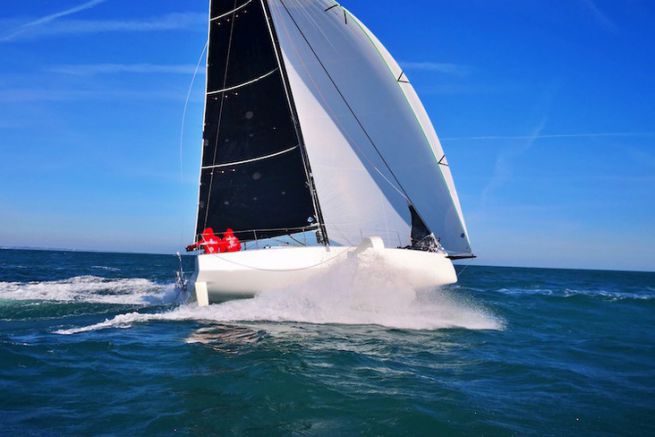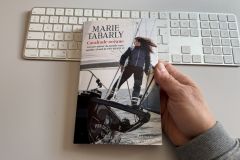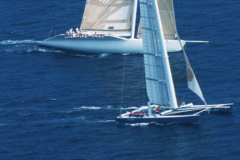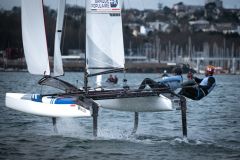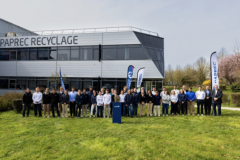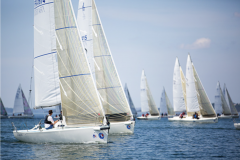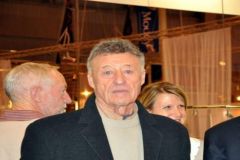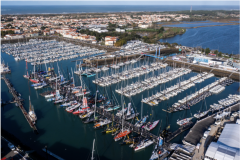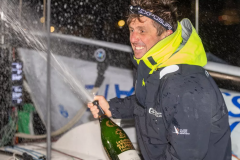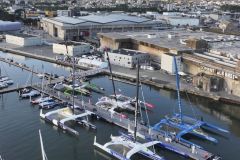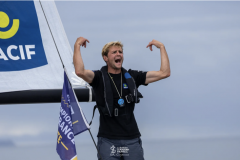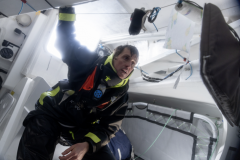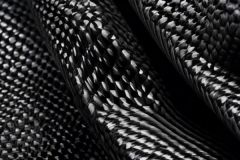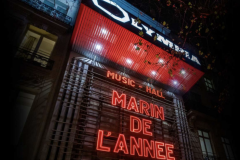On Tom Dolan's boat, we leave the pontoon and immediately take out the foils, which will not have returned to port until the boat is back in port.
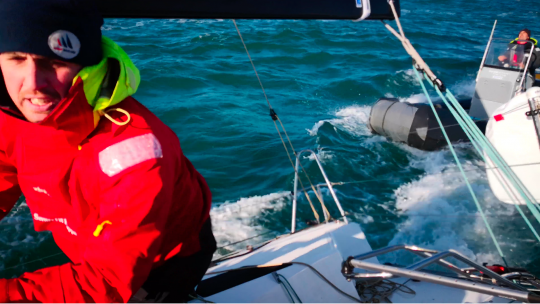
We hoist the brand new sails, stop the small engine, and quickly reach the starting line.
- 5-minute countdown launched...
This line is not wet in front of the wind, we will start at full speed.
- 4 minutes before departure...
On Tom Dolan's boat, we know that we are missing the ideal sail for this tack, namely the gennaker, it is being finished. Will we be able to follow the autres?? It's a training, but we don't want to be extras. We're going to give everything we have to be in on it.
- 3 minutes...
We decide (at the last moment) on a strategy to overcome our handicap. We will start downwind of the fleet that has rolled out its gennaker and we will probably be able to force them to luff under gennaker. Which, we hope, will cause a stir by sending our comrades to tas?!
- 2 minutes before the top...
Then when we are upwind of them, we can send the spinnaker and descend to the buoy at full speed... The tension has increased a notch. It's a little difficult to start the machine.
- 1 minute...
F/*#!! Let go of our Irishman. This is retard?!
- Top départ?!
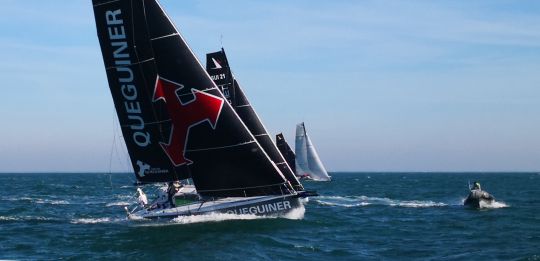
Indeed, we arrive on the line 5 seconds late. Enough to get our plan in the water. At this level of competition, error is not forgivable. Our boat is relegated to a short length behind a competitor sailing under gennaker. In its disturbed wind, we will have difficulty getting through it.
But surprise?! Under genoa and mainsail, we go fast. We observe our comrades, some of them have hoisted the gennaker like Fabien Delahaye, others sail under small spinnaker like Justine Mettraux. On Tom Dolan's Figaro 3, we are not yet gliding, but the wind seems to be getting stronger.
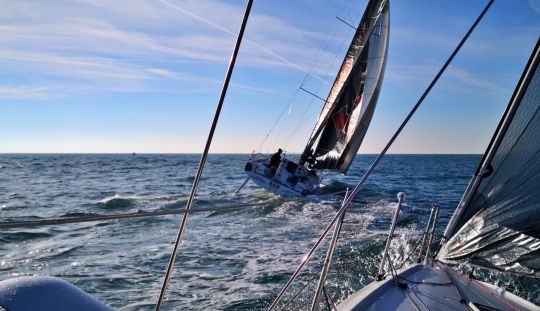
We're struggling with the adjustments to keep in touch with the pack of champions and that marche?! We are better than those who tried the little spinnaker, for them it is the fight to avoid the start at the luff.
Arriving at our cardinal Les Chats, there is a regrouping of the fleet before the next exercise.
In 5 minutes, new start for a speed test under small spinnaker.
3, 2, 1, 1, Top?! The spis swell.
One of the pair sent his spinnaker upside down, reversing the tack and halyard. It happens to even the best. Coach's Remonstration: a felt marking is necessary to avoid repeating the error.
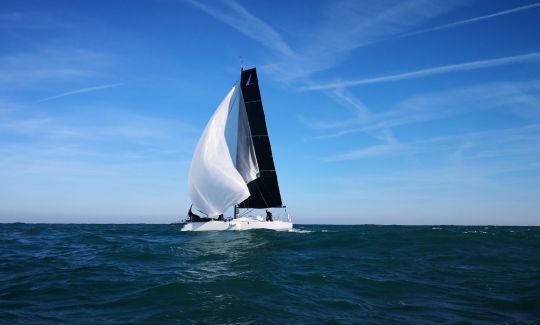
As soon as the sails are well established, let's go. Charles Caudrelier and Delahaye make the powder speak, their driving of the boat under spinnaker is impressive. The gite is optimal, the longitudinal pitch is stable, the speed is very high.
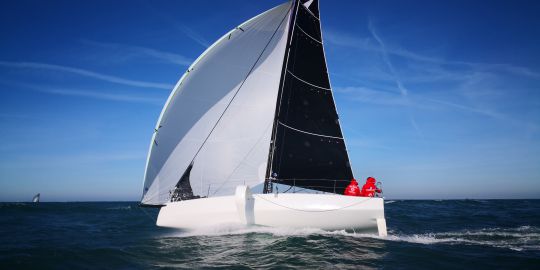
A crew experienced equipment problems and their spinnaker collapsed in the water. The halyard stitch has failed. The coach is there, assisting the sailors and giving wise advice to recover the track without tearing it on the foils or rudders.
Complex gybes
We make a few gybes towards Pen Men, west of the island of Groix. On board the Figaro 3, the exercise is still far from being fluid and fast. The skippers will need work to perfect their gestures and their sequence
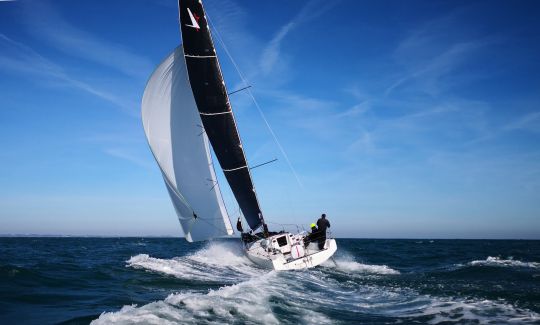
The gybes will have to be worked on, as the Figaro 3 has a small bowsprit. This leaves a narrow corridor between the forestay and the luff of the spinnaker to allow the entire sail to pass through. In addition, the ergonomics of listening operations are not perfect. So the gybes are very decomposed. First we pass the spinnaker and chisel it. Then when it is established, we go through the GV. It's a little slow, but there's little risk of losing all your speed or going to the luff when you get out of the gybe.
The coach, gives advice to a crew that misses its gybing "Let go of the spinnaker listening at empannage?! The clew point must reach the forestay, otherwise the canvas will collapse on the forestay. "
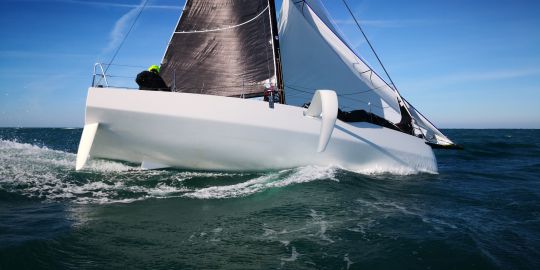
The Figaro 3 glides at 14/15 knots
We are already south of Groix, the speeds are very high, we can hear the foils singing. The coach goes from boat to boat, which glide at 14/15 knots with a tight beam. He observes and advises, in collaboration with the skippers he proposes adjustments. While driving he takes pictures and videos, which together with the notes will allow a quality debriefing.

We have to luff as much as possible to wind the tip of Groix. The spis are at the limit of their tolerance and are slumped one after the other. Sailors who have a spinnaker sock lose little ground when they sink, this is a point on which there will be a collective discussion.
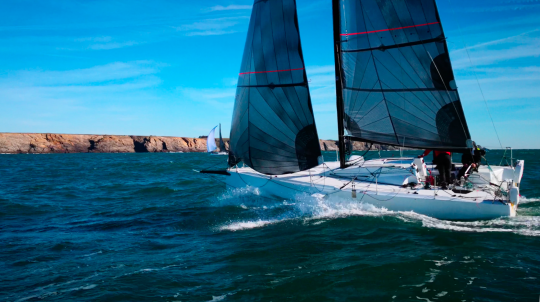
The last upwind leg should take us back to Lorient with an arrival at the foot of the Vauban citadel in Port-Louis.
Upwind, the speeds of the boats are quite similar. But already, some skippers are discovering the keys to the boat, it's talent. In just a few minutes of upwind adaptation, Morgan Lagravière laid his Figaro 3 flatter than the others and won in the wind. It is a pity that it does not yet have a budget, because according to its competitors it is formidable.

In a few moments, we lost Caudrelier and Delahaye who suffer from an algae in the keel veil. The boat is surprisingly sensitive to the drag of algae, so there will also be a collective discussion on this point.
One last spinnaker in the wind that is running out of breath to pass the Vauban citadel and this day of sailing is coming to an end.
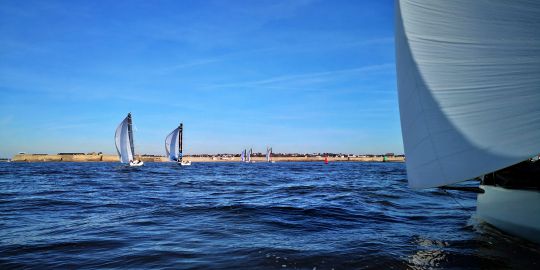
Debriefing, the collective's added value
Arrived at the pontoon we will have a few minutes to store the boats. We put down the waxes and meet for the collective debriefing with the trainer.
"The boat is not that easy to maneuver" notes Tanguy the Glatin. A round table discussion and everyone agrees that the edges of the beam were exhilarating.
The first side is mentioned, which was a general surprise. We found few speed differences on monotypes with 4 different sail configurations (genoa GV?; small genak GV/big genak GV, small spinnaker GV)
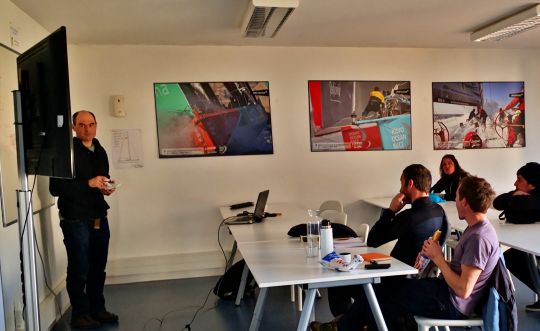
We discuss driving under asymmetric spinnaker and gennaker: since his semi-rigid the coach has made observations to optimize speed. We are talking about deck fittings and rigging, sail changes. Morgan Lagravière gives his analysis on the anti-drift plan and the upwind adjustments specific to the Figaro 3.
Everyone shares their impressions and analyses, this is the strength of the group. Sharing experiences allows everyone to improve. The group improves as the individual progresses.
